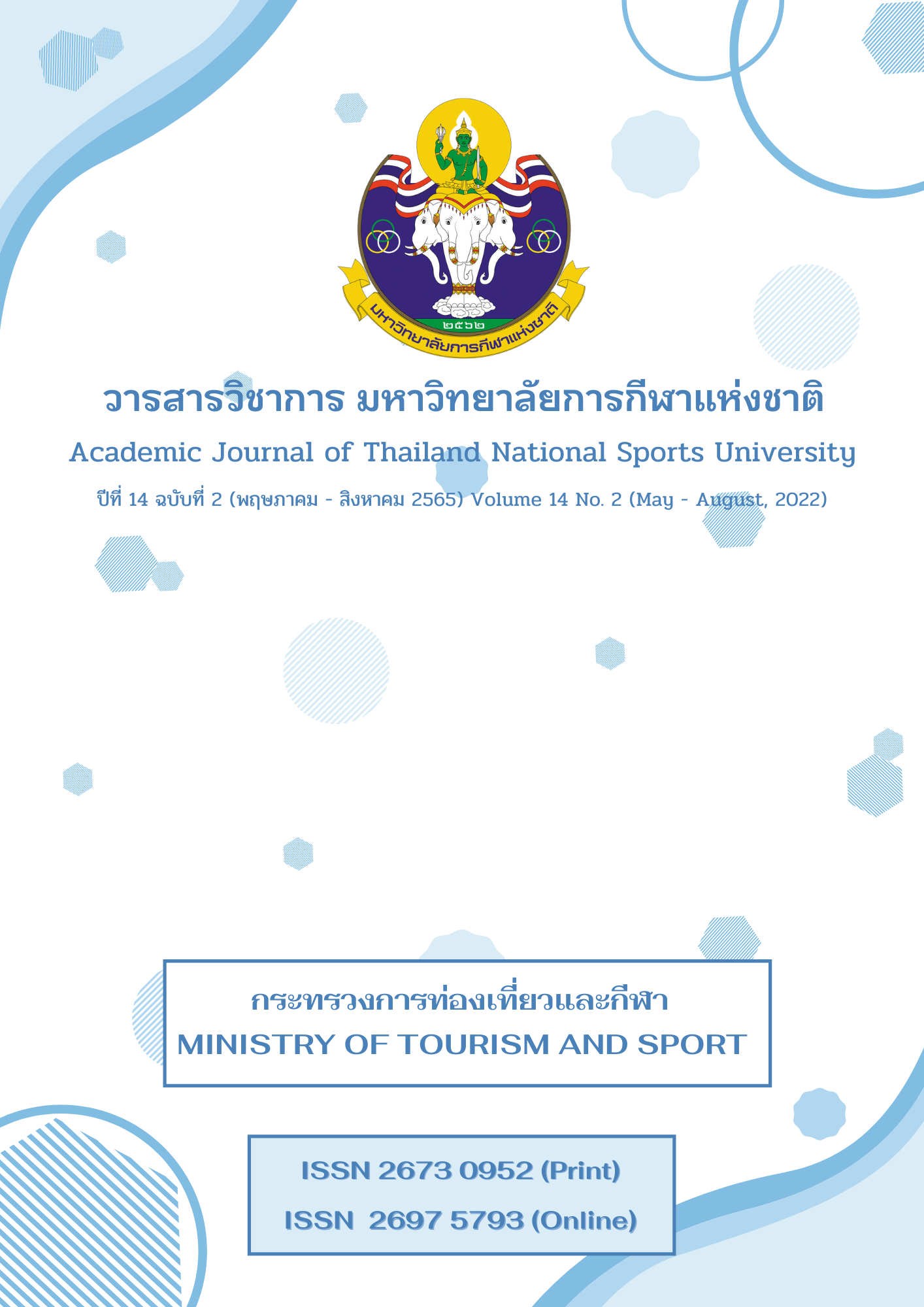A STUDY OF QUALITY OF LIFE OF PHYSICAL EDUCATION TEACHERS IN PHAYAO PROVINCE
Main Article Content
Abstract
The purposes of this study were to study the level and personal factors related to the quality of life and compare the quality of life of physical education teachers classified by sex, income and age range. The instrument used in this research were questionnaires of World Health Organization Quality of Life Brief- Thai with reliability 0.95. The sample group was 201 physical education teachers in the office of the basic education commission, Phayao province, academic 2020. The data were analyzed by using mean and standard deviation, Pearson product moment correlation, Independent Sample t - test and One - way ANOVA were employed for significance at the .05
The research findings were as follow:
- The quality of life of physical education teachers in Phayao Province in terms of quality of life and overall health was at the moderate level (92.86) and the quality of life in terms of physical, psychological, social relationship and environmental domain also was at the moderate level with 24.06, 21.70, 11.40 and 28.40 respectively.
- The factors correlated with quality of life of physical education teachers in Phayao province were not significantly differences.
- The comparison of the quality of life of physical education teachers in Phayao Province was found at the moderate level both male (M = 3.59, S.D. = 0.58) and female (M = 3.52, S.D. = 0.44), and there were no significant differences.
4. The comparison of the quality of life of physical education teachers in Phayao province classified age rang and average income; there were no significant differences.
Article Details

This work is licensed under a Creative Commons Attribution-NonCommercial-NoDerivatives 4.0 International License.
The published article is a copyright of the Academic Journal of Thailand National Sports University. The passage appeared in each article in this academic journal is a perspective of each author which is not related to the journal. Each author is required to be responsible for all components of his/her own article. If there are any mistakes, each author must be responsible for those mistakes on his/her own.
References
Boonchom Sisaat. (2011). Introduction to Research (9th ed.). Bangkok: Suweeriyasan.
Chachoengsao Primary Education Service Area Office 2. (2011). Fiscal Year Action Plan 2010. Chachoengsao. Policy and Planning Group.
Chumporn Chumsaeng, Umaporn Kenesila, Naina Tangjaidee, & Kittipong Kongsomboon. (2012). Factors influencing the quality of life of nursing department personnel at Her Royal Highness Princess Maha Chakri Sirindhorn Medical Center Nakhonnayok Province. Faculty of Medicine, Srinakharinwirot University.
Krejcie, R. V., & Morgan, D. W. (1970). “Determining Sample size for research activities.” Education and Psychological Measurement, 30(3), 607 – 610.
Maslow, Abraham H. (1954). Motivation and Personality. New York: Harpers and Row.
Ministry of Education. (2008). Thai Basic Education Core Curriculum A.D. 2008. Bangkok; The Agricultural Cooperative Federation of Thailand. Limited
Ministry of Tourism & Sports. (2017). The National Sports Development Plan No.6. Retrieved from http://www.mots.go.th/ewt_dl_link.php?nid=8408
Mongkhon Larvanna. (2008). Quality of working life of national research council of Thailand (Master’s thesis), Mahidol University.
Office of Phayao Province. (2018). Phayao Province Development Plan (2018 - 2022). Retrieved from http://www.oic.go.th/FILEWEB/CABINFOCENTER66/DRAWER028/ GENERAL/DATA0000/00000538.PDF
Office of the National Economic and Social Development Council. (2016). The Eleventh National Economic and Social Development Plan (2017 - 2021). Retrieved from http://www.nesdb.go.th/Portals/0/news/plan/p11/plan11.pdf
Phayao Provincial Education Office. (2020). Information Academic year 2019. Retrieved from http://www.pyopeo.moe.go.th
Phayao Teacher Saving Cooperative Limited. (2017). Public relations message Phayao Teacher Saving Cooperative. Retrieved from http://www.phayaotcl.com/publicize.php
Sirinan Kittisuksathit, Chalermpol Chaemchan, Kanchana Tangcholthip & Jaramporn HoLamyong. (2012). Quality of Life, Work and Happiness. Institute for Population and Social Research, Mahidol University. Thammada Press.
Suwat Mahatnirankul, Wirawan Tantipiwattanasakul, Wanida Pumphaisanchai, Krongjit Wongsuwan and Varane Pornmanarangkul. (2002). The World Health Organization Quality of Life Brief Thai (WHOQOL – BREF - THAI). Department of Mental Health, Ministry of Public Health. Retrieved from https://www.dmh.go.th/test/whoqol/
Tasanee Chatthai. (2016). Quality of Working Life of Personnel at Dhurakij Pundit University. Research Report, Dhurakij Pundit University. Retrieved from http://libdoc.dpu.ac.th/ research/159565.pdf
The Secretariat of the House of Representatives. (2017). Academic Report of the Congressional Budget Office, Issue 7/2017, Expense Budget for Health Service System. Retrieved from https://dl.parliament.go.th/handle/lirt/547294
Wassana Kunapisit. (2013). The goals of physical activity in educational institutions are aligned with thai basic education core curriculum. Journal of Health, Physical Education and Recreation, 39(1), 16 - 39.
Worasak Phianchob. (2005). Includes Articles on Philosophy, Principles, Teaching Methods, and Measurement for Physical Education Evaluation. Chulaongkorn University Press.
World Health Organization. (1996). WHOQOL - BREF introduction, administration, scoring and generic version of assessment. Retrieved from https://apps.who.int/iris/handle/ 10665/63529


